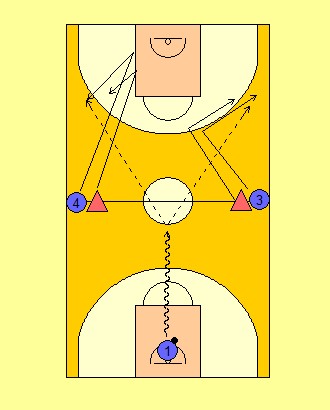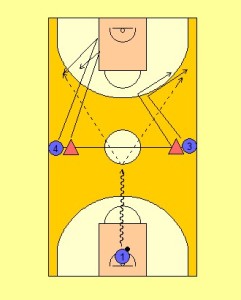Link Passing Transition Drill

The Link Passing Transition Drill integrates the use of all possible passes within basketball while proving a scenario specific to practicing one of the more troublesome aspects of transition, the second or link pass.
The Link Passing Transition Drill starts with an offensive player (One) positioned under the basket at one end of the floor. This player starts with the basketball. This player will look to dribble down the floor and perform a specific type of basketball pass to one of the wing running offensive players (Three and Four).

The wing runners start at halfway at the “T” point. A defender also starts at this position and attempts to deny the pass to the player and ultimately prevent the scoring opportunity.
The wing players look to create leads and in so doing become possible passing targets for One (1).
If a wing player (Three or Four) receive the link pass the drill becomes live (2 v 2) and continues until either the offense scores, or the defence securers possession.
Points of Emphasis
A key focus of the Link Passing Transition Drill is to have players perfect a wide range of different passing techniques utilised in basketball.
An effective link pass pushes the ball from the defensive end of the floor into an attacking position. If the link pass is poor offensive players will catch the ball away from a position in which they are considered a threat by the defence. Ideally, the wing players (Three and Four) should be catching the ball at the three-point line or closer to the basketball hoop.
Variations
While in the above diagram the offensive player filling the role of the outlet initially starts in the middle of the floor, this starting position can vary. Once a player becomes competent in performing a range of passes, then look to start the player from the corners of the floor. This will varying the line of sight for players and make the challenge of passing to the opposite side of the floor more challenging.
While it is not ideal for players to pass across the splitline, practicing the passing angles will assist in players being able to perform this task more efficient and effectively.
Once the players have overcome the challenges and acquired the knowledge to play from various angles, the next variation focuses on adding an on-ball defender from the outlet. The defender marking One (1) will attempt to deny or pressure the link pass to the forward offensive targets.
As the competence of the players develop an additional player can be added to the drill that acts as the inbounder, again with an on-ball defender.
The last variation to the Link Passing Transition Drill is to provide two outlet targets. These players will simulate a regular inbounding situation during a game where two offensive players remain in the backcourt acting as possible targets on opposite side of the floor.
In all variations of the Link Passing Transition Drill different passes should be made mandatory of players.
The Link Passing Transition Drill if performed well will see better outcomes for a team in being able to move the ball quickly up the floor. At all times players should look to work at the highest speed to assist in the realistic development of the desired range of skills.


Leave a Reply